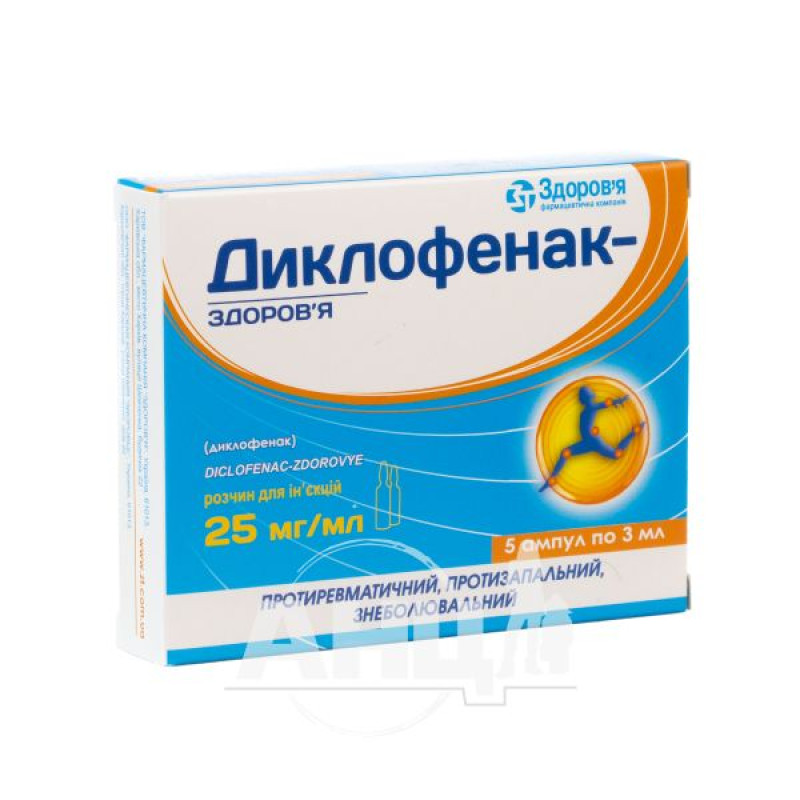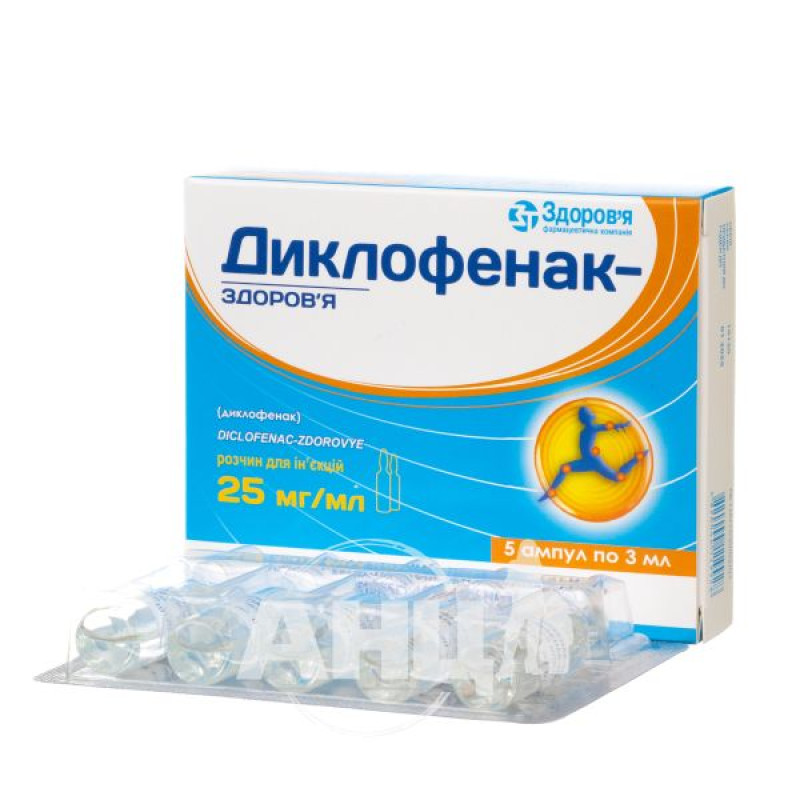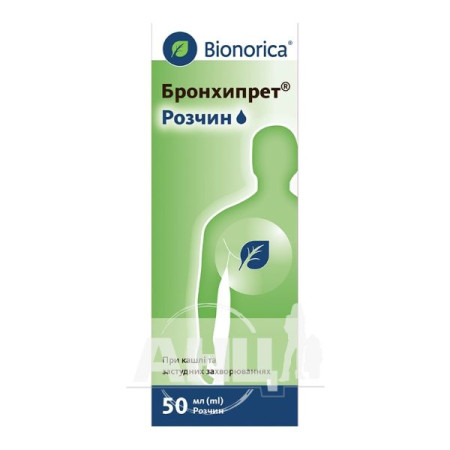Diclofenac-Zdorovye solution for injection 2.5% ampoule 3 ml No. 5

Diclofenac-Zdorovye injection solution is used for the indications listed below.
When administered intramuscularly, it is intended for the treatment of:
inflammatory and degenerative forms of rheumatism, rheumatoid arthritis, ankylosing spondylitis, osteoarthritis, spondyloarthritis, vertebral pain syndrome, non-articular rheumatism; acute attacks of gout; renal and biliary colic; pain and swelling after injuries and operations; severe migraine attacks.The drug, when administered as an intravenous infusion, is intended for the treatment or prevention of postoperative pain.
Composition
Active ingredient: diclofenac (1 ml of solution contains diclofenac sodium 25 mg).
Excipients: sodium metabisulfite (E 223), mannitol (E 421), propylene glycol, benzyl alcohol, sodium hydroxide, water for injections.
Contraindication
hypersensitivity to the components of the drug, sodium metabisulfite; history of gastrointestinal bleeding or perforation associated with previous treatment with nonsteroidal anti-inflammatory drugs (NSAIDs); active peptic ulcer/bleeding or history of recurrent peptic ulcer/bleeding (two or more separate episodes of established ulceration or bleeding); III trimester of pregnancy; like other NSAIDs, diclofenac is also contraindicated in patients in whom the use of ibuprofen, acetylsalicylic acid or other NSAIDs provokes attacks of bronchial asthma, angioedema, urticaria or acute rhinitis; inflammatory bowel diseases (e.g. Crohn's disease or ulcerative colitis); hepatic failure; renal failure (creatinine clearance <15 ml/minute/1.73 m2); congestive heart failure (NYHA II-IV); high risk of postoperative bleeding, blood clotting, hemostasis disorders, hematopoietic disorders or cerebrovascular bleeding; treatment of perioperative pain in coronary artery bypass grafting (or use of an artificial circulatory device); ischemic heart disease in patients with angina pectoris, myocardial infarction; cerebrovascular disease in patients with stroke or transient ischemic attacks; peripheral arterial disease.For intravenous use only:
concomitant use of NSAIDs or anticoagulants (including high doses of heparin); history of hemorrhagic diathesis, confirmed or suspected cerebrovascular bleeding in history; operations associated with a high risk of bleeding; history of bronchial asthma; moderate or severe renal impairment (serum creatinine> 160 μmol/l); hypovolemia or dehydration due to any cause.Method of application
The dose should be selected individually, starting from the minimum effective dose, and the drug should be used in the minimum effective dose for the shortest possible period of time, taking into account the treatment objectives for each individual patient. Do not use for more than 2 days. If necessary, treatment can be continued with other dosage forms of diclofenac.
One ampoule is for single use only. The solution should be used immediately after opening the ampoule. Any unused contents should be discarded.
Intramuscular injection
The following precautions should be taken to prevent damage to nerves or other tissues at the injection site. Such damage can lead to muscle weakness, muscle paralysis, and paresthesia.
The dose is usually one 75 mg ampoule per day by deep injection into the upper outer quadrant of the gluteal muscle. In severe cases (e.g. colic), the daily dose may be increased to two 75 mg injections, several hours apart (one injection in each buttock). Alternatively, one 75 mg ampoule may be combined with other dosage forms (e.g. tablets, suppositories) up to a total maximum daily dose of 150 mg.
In the setting of migraine attacks, clinical experience is limited to cases with the initial use of one 75 mg ampoule, the dose should be administered if possible immediately after the use of 100 mg suppositories on the same day (if necessary). The total daily dose should not exceed 175 mg on the first day. There are no data available on the use of the drug in the treatment of migraine attacks for more than one day.
Intravenous infusions
The drug should not be administered as a bolus injection. Immediately before the start of the diclofenac infusion, depending on its required duration, the contents of one ampoule of the drug should be diluted in 100-500 ml of 0.9% sodium chloride solution or 5% glucose solution, buffered with sodium bicarbonate solution for injection (0.5 ml of 8.4% solution or 1 ml of 4.2%, or the corresponding volume of another concentration), which is taken from a freshly opened container. Only clear solutions can be used. If there are crystals or sediment in the solution, it cannot be used for infusion.
For the prevention of postoperative pain, a loading dose of 25-50 mg should be administered 15 minutes to 1 hour after surgery, followed by a continuous infusion of approximately 5 mg/h up to a maximum daily dose of 150 mg.
Application features
Pregnant women
In the I and II trimesters of pregnancy, the drug can be prescribed only if the expected benefit to the mother outweighs the potential risk to the fetus and only in the minimum effective dose. The duration of treatment should be as short as possible.
Like other non-steroidal anti-inflammatory drugs, diclofenac passes into breast milk in small amounts. Therefore, to avoid undesirable effects on the infant, the drug should not be used during breastfeeding.
Like other nonsteroidal anti-inflammatory drugs, the drug may affect female fertility. The drug is not recommended for women planning pregnancy. Women who have difficulty conceiving or who have undergone infertility testing should discontinue use of the drug.
Children
The drug in this dosage form should not be used in children.
Drivers
Patients who experience visual disturbances, dizziness, drowsiness or other nervous system disorders during treatment with diclofenac should refrain from driving or operating machinery.
Overdose
Symptoms
There is no typical clinical picture of the consequences of diclofenac overdose. Overdose can cause symptoms such as headache, nausea, vomiting, epigastric pain, gastrointestinal bleeding, diarrhea, dizziness, disorientation, agitation, coma, drowsiness, tinnitus, loss of consciousness or convulsions. In case of severe poisoning, acute renal failure and liver damage are possible.
Treatment
Activated charcoal should be considered within one hour of ingestion of a potentially toxic amount. In addition, gastric lavage should be considered in adults within one hour of ingestion of a potentially toxic amount. Diazepam should be administered intravenously if seizures are frequent or prolonged. Other measures may be indicated depending on the clinical condition of the patient. Treatment is symptomatic.
Side effects
The following side effects include those associated with the administration of diclofenac sodium in both short-term and long-term use.
From the blood and lymphatic system: thrombocytopenia, leukopenia, anemia (including hemolytic and aplastic), agranulocytosis.
Immune system disorders: hypersensitivity, anaphylactic and anaphylactoid reactions (including hypotension and shock), angioedema (including facial edema).
Mental disorders: disorientation, depression, insomnia, nightmares, irritability, and other mental disorders.
Nervous system: headache, dizziness, drowsiness, fatigue, paresthesia, memory impairment, convulsions, anxiety, tremor, aseptic meningitis, taste disturbance, stroke, confusion, hallucinations, sensory disturbances, general malaise.
On the part of the organ of vision: visual impairment, blurred vision, diplopia, optic neuritis.
From the side of the organs of hearing and labyrinth: vertigo, tinnitus, hearing impairment.
Cardiac: palpitations, chest pain, heart failure, myocardial infarction, Kounis syndrome.
From the vascular system: arterial hypertension, arterial hypotension, vasculitis.
Respiratory, thoracic and mediastinal disorders: asthma (including dyspnea), pneumonitis.
On the part of the digestive system: nausea, vomiting, diarrhea, dyspepsia, abdominal pain, flatulence, gastritis, intestinal bleeding, vomiting with blood, hemorrhagic diarrhea, melena, gastric or intestinal ulcer with bleeding, gastrointestinal stenosis with perforation (sometimes fatal, especially in elderly patients), which can lead to peritonitis; colitis (including hemorrhagic colitis and exacerbation of ulcerative colitis or Crohn's disease), constipation, stomatitis (including ulcerative stomatitis), glossitis, esophageal disorders, membranous intestinal strictures, pancreatitis.
Hepatobiliary disorders: increased transaminase levels, hepatitis, jaundice, liver function abnormalities, transient hepatitis, hepatonecrosis, hepatic failure.
Skin and subcutaneous tissue disorders: skin rash, urticaria, bullous eruptions, eczema, erythema, erythema multiforme, Stevens-Johnson syndrome, Lyell's syndrome, exfoliative dermatitis, hair loss, photosensitivity reaction, purpura, allergic purpura, pruritus.
Renal and urinary disorders: acute kidney injury (acute renal failure), hematuria, proteinuria, nephrotic syndrome, interstitial nephritis, renal papillary necrosis.
General disorders and administration site conditions: injection site reaction, pain, induration, swelling, injection site necrosis, injection site abscess.
Reproductive system and breast disorders: impotence.
There is evidence of a possible increased risk of thrombotic complications (e.g. myocardial infarction or stroke) associated with the use of diclofenac, particularly at high therapeutic doses (150 mg per day) and with long-term use.
Interaction
Storage conditions
Store in the original packaging at a temperature not exceeding 25 °C, out of the reach of children.
Shelf life - 5 years.
There are no reviews for this product.
There are no reviews for this product, be the first to leave your review.
No questions about this product, be the first and ask your question.







